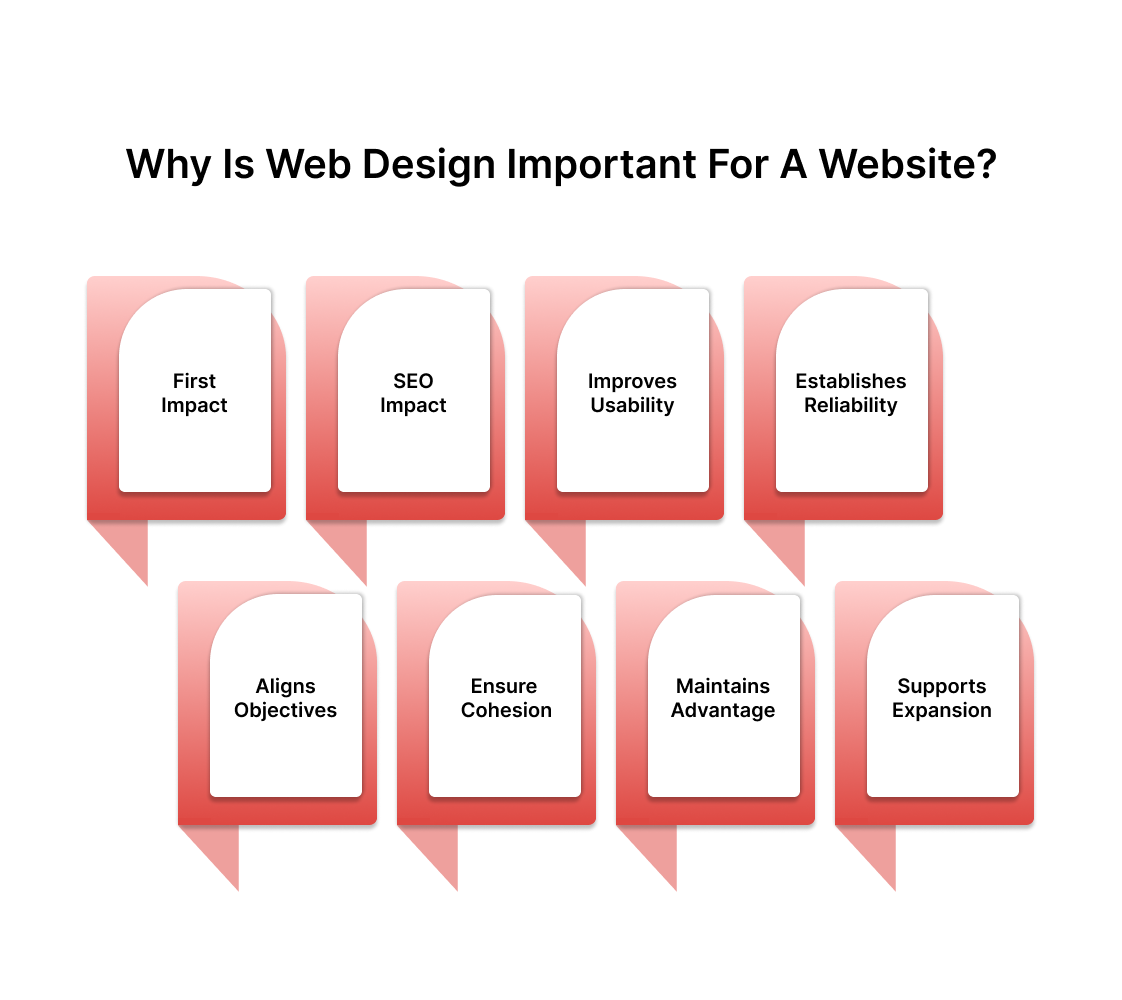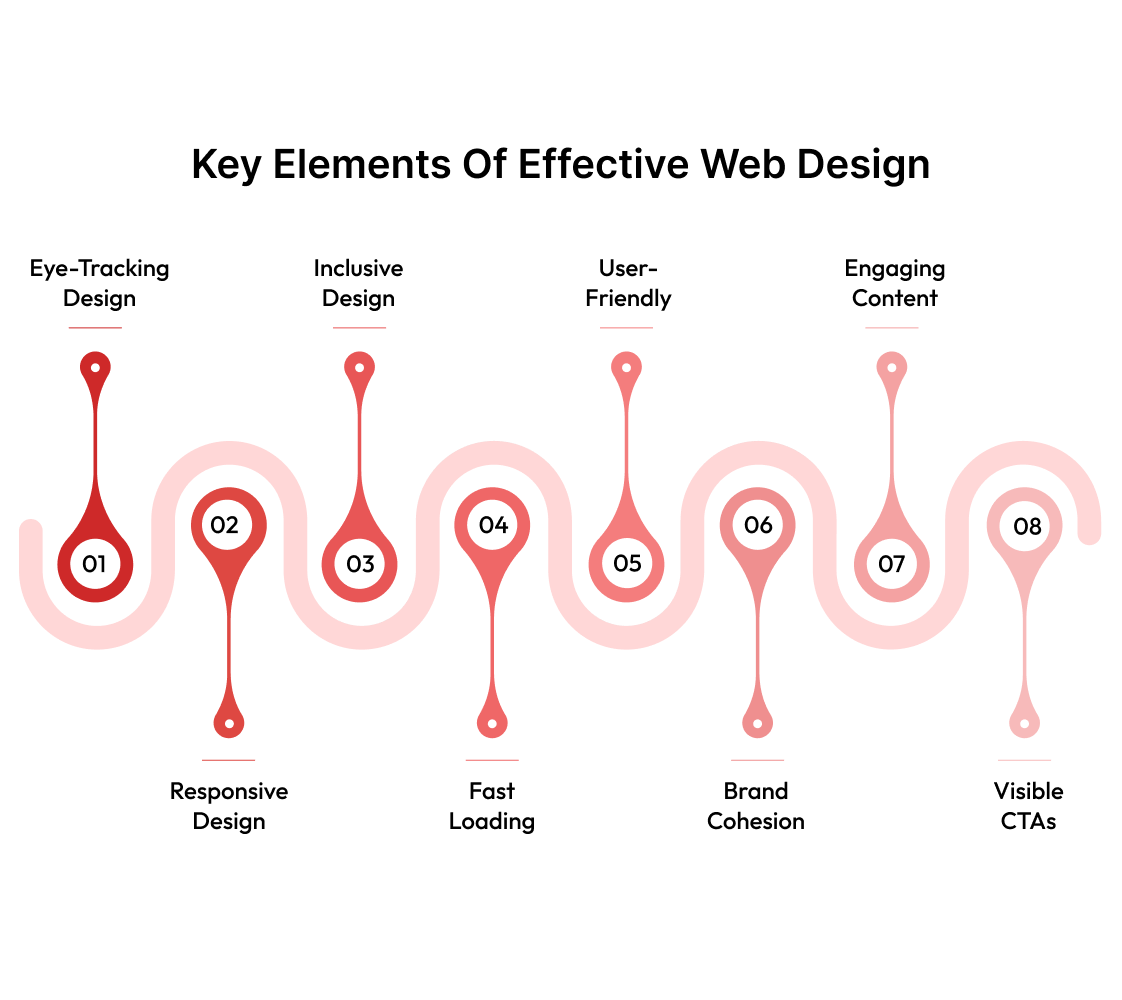A website’s design is the first and sometimes only chance you get to earn a visitor’s trust. In fact, users form an opinion about your site in just 50 milliseconds. If the layout is confusing or the visuals look outdated, 94% of people will leave your website.
Despite these numbers, many businesses still treat design as an afterthought. The result? Missed opportunities, higher bounce rates, and stagnant growth. As competition intensifies and buyer expectations rise, design is no longer just about looking good, it’s about delivering a seamless, credible experience that directly impacts conversions and brand perception.
In this blog, you’ll discover why website design is a critical business driver.
Key takeaways
- Web design shapes how visitors perceive your brand, with first impressions made in milliseconds.
- It plays a key role in SEO, improving online visibility through mobile responsiveness, fast load times, and structured content.
- A well-designed website enhances user experience (UX), making navigation intuitive and reducing bounce rates.
- Consistent branding across your site fosters trust and helps reinforce your brand’s identity.
- Good web design is not just about looks; it directly impacts conversions, engagement, and long-term business success.
What Is Web Design?
Web design is the process of planning, conceptualizing, and arranging content and visual elements online to create an engaging, intuitive, and effective user experience. Modern web design integrates visual hierarchy, usability, accessibility, and brand alignment to ensure visitors can easily find what they need, trust your business, and take action.
A well-designed website typically includes:
- Visual hierarchy: Using layout, color, and typography to guide users’ attention to key information.
- Responsiveness: Ensuring the site adapts seamlessly to all devices and screen sizes.
- Accessibility: Designing so everyone, including users with disabilities, can navigate and interact with the site.
- Performance: Optimizing for fast load times and smooth interactions, which directly impact user satisfaction and conversion rates.
Web Design vs. Web Development: Key Differences
While web design and web development are closely related, they serve distinct roles in building a successful website:
You’ve just seen what web design actually means. But why does it matter for your business or project? Let’s look at the real reasons web design deserves your attention.
Why Is Web Design Important for a Website?

A website design is a strategic tool that shapes how your business is perceived, how users interact with your content, and how effectively you achieve your goals. Here’s an in-depth look at why web design is crucial for any business:
1. Sets the First Impression
Your website is often the first point of contact between your business and potential customers. Within seconds, visitors form an opinion about your brand based on your site’s design.
An attractive, modern, and well-organized website communicates professionalism and reliability, while an outdated or cluttered site can create distrust and drive users away. This initial impression can determine whether a visitor stays to learn more or leaves for a competitor.
2. Directly Influences SEO and Online Visibility
Web design isn’t just about visuals, it plays a vital role in how search engines crawl, interpret, and rank your site. Elements such as mobile responsiveness, page speed, clean code, and structured content all impact your SEO performance. A site built with SEO best practices makes it easier for search engines to index your pages and for users to find you online, giving your business a stronger digital presence.
3. Enhances User Experience (UX)
A well-designed website prioritizes usability, making it easy for visitors to find information, complete tasks, and engage with your content. Clear navigation, logical page structure, and intuitive layouts reduce friction, keeping users engaged and encouraging them to explore further. Good UX not only increases satisfaction but also boosts the likelihood of repeat visits and conversions.
4. Builds Trust and Credibility
Trust is fundamental in online interactions. A professional, cohesive web design signals that your business is legitimate and attentive to detail. Consistent branding, high-quality visuals, and clear messaging all contribute to a trustworthy image. When users feel confident in your site, they’re more likely to engage with your business and become loyal customers.
5. Supports Your Business and Marketing Goals
Every element of your website should be aligned with your objectives, whether that’s generating leads, making sales, or building brand awareness. Strategic placement of calls-to-action, optimized landing pages, and persuasive content all work together to guide users toward your desired outcomes. Effective web design turns your site into an active tool for business growth, not just a digital brochure.
6. Creates Consistency Across Your Brand
Consistency in design, using the same colors, fonts, and layouts across all pages, reinforces your brand identity and makes your business more memorable. This uniformity helps users recognize your brand instantly and builds a sense of familiarity, which is essential for long-term customer relationships.
7. Keeps You Competitive
Your competitors are investing in professional web design to attract and retain customers. If your site looks outdated or is difficult to use, you risk losing business to companies with more appealing and functional websites. A well-designed site not only helps you stand out but also ensures you’re meeting (or exceeding) industry standards.
If you’re aiming for a site that not only looks sharp but also drives real results, Beetle Beetle brings a strategic approach to web design that’s tailored to your growth targets.
8. Enables Scalability and Future Growth
A thoughtfully designed website is built to evolve with your business. Whether you need to add new features, expand content, or integrate with other platforms, a solid design foundation makes updates easier and more cost-effective over time. This scalability ensures your website remains a valuable asset as your business grows.
Now that we’ve covered why web design really matters, let’s get into what actually makes a website stand out. Here are the key elements that turn a good site into a great one.
Key Elements of Effective Web Design

A truly effective website isn’t just visually appealing, it’s built on a foundation of smart design choices that keep visitors engaged and help your business achieve its goals. Here’s what separates a forgettable website from one that leaves a lasting impression:
1. Visual Hierarchy That Guides the Eye
Imagine landing on a page where your attention is instantly drawn to what matters most. That’s the power of visual hierarchy. By using size, color, contrast, and spacing, great design leads your visitors straight to headlines, calls-to-action, and essential content making every interaction feel effortless and purposeful.
2. Mobile Responsiveness for Today’s Audience
Your audience is everywhere: on phones, tablets, and desktops. A responsive website adapts to every screen, ensuring your content always looks sharp and functions smoothly. This isn’t just a technical detail; it’s a must for delivering a seamless experience and keeping visitors engaged, no matter how they access your site.
3. Accessibility That Welcomes Everyone
An inclusive website is one that everyone can use, regardless of ability. Accessible design means clear text, keyboard-friendly navigation, and thoughtful color choices. It’s about opening your digital doors to a wider audience and showing that your brand cares about every visitor.
4. Speed That Keeps Users Engaged
Few things are more frustrating than a slow website. Optimizing images, streamlining code, and using reliable hosting all contribute to fast load times. When your site loads quickly, visitors are more likely to stay, explore, and take action—while search engines reward you with better visibility.
5. Clear and Intuitive Navigation
Visitors shouldn’t have to guess where to click next. Effective navigation uses straightforward menus, logical page groupings, and visible search features to help users find what they need—fast. When your site feels easy to explore, people stick around longer and accomplish more.
6. Consistent Branding Across Every Page
Your website is your digital storefront. Consistent use of colors, fonts, and imagery builds recognition and trust, making your business instantly memorable. Every detail, from your logo placement to your tone of voice, should reflect your brand’s personality.
7. Content That Connects and Converts
Design and content go hand in hand. Clear, concise messaging paired with readable fonts and strategic whitespace makes it easy for visitors to absorb information. Well-crafted content not only informs but also guides users toward your key business goals.
8. Calls-to-Action That Stand Out
A great website doesn’t leave visitors guessing what to do next. Strong, visually distinct calls-to-action like “Contact Us,” “Get a Quote,” or “Start Free Trial”. When CTAs are easy to spot and compelling, your site becomes a powerful driver of results.
By weaving these elements together, you create a website that’s not just attractive, but also intuitive, inclusive, and built for real business impact.
Unlock the Full Potential of Your SaaS Website with Beetle Beetle
Your website shouldn’t just look good, it should be your highest-performing sales asset. For ambitious B2B SaaS companies, this means more than a visual upgrade; it’s about positioning your product above the competition, generating qualified leads, and communicating your true value to the right audience.
Beetle Beetle is not your typical web design agency. As a specialized B2B SaaS website revamp partner, Beetle Beetle combines deep research, strategic messaging, and design-first execution to transform underperforming sites into growth engines.
Our team dives deep to understand your market, clarify your positioning, and simplify complex offerings, ensuring your site resonates with prospects and drives measurable results.
Beetle Beetle helps brands:
- Capture more qualified leads through clear calls-to-action and streamlined forms
- Build trust with consistent branding, fast load times, and accessible design
- Stand out in competitive markets by aligning design with business goals and SEO strategy
Ready to see what a high-converting SaaS website can do for your business?
Schedule a call with Beetle Beetle and capture the market before your competitors even know what happened.
FAQs
1. How does good web design impact my business’s credibility?
A well-designed website signals professionalism and reliability to visitors. Clean layouts, consistent branding, and intuitive navigation help establish trust, making users more likely to engage with your SaaS product.
2. Why is mobile responsiveness important for modern websites?
With most users browsing on mobile devices, a responsive website ensures your content looks and functions well on any screen size. This improves user satisfaction and can positively affect your search engine rankings.
3. How can I tell if my website needs a redesign?
If your site looks outdated, loads slowly, isn’t mobile-friendly, or doesn’t align with your current branding and business goals, it might be time for a redesign. High bounce rates and low conversions are also strong indicators.
4. How does web design affect SEO?
Good web design supports SEO by improving site speed, mobile usability, and content structure. Features like clean code, optimized images, and logical navigation help search engines better understand and rank your site.
5. What should I look for in a SaaS website design partner?
Look for a partner with SaaS industry expertise, a strategic approach to messaging and user experience, and a portfolio of measurable results. Beetle Beetle brings all these qualities, making them a strong choice for ambitious SaaS brands.


.png)





























